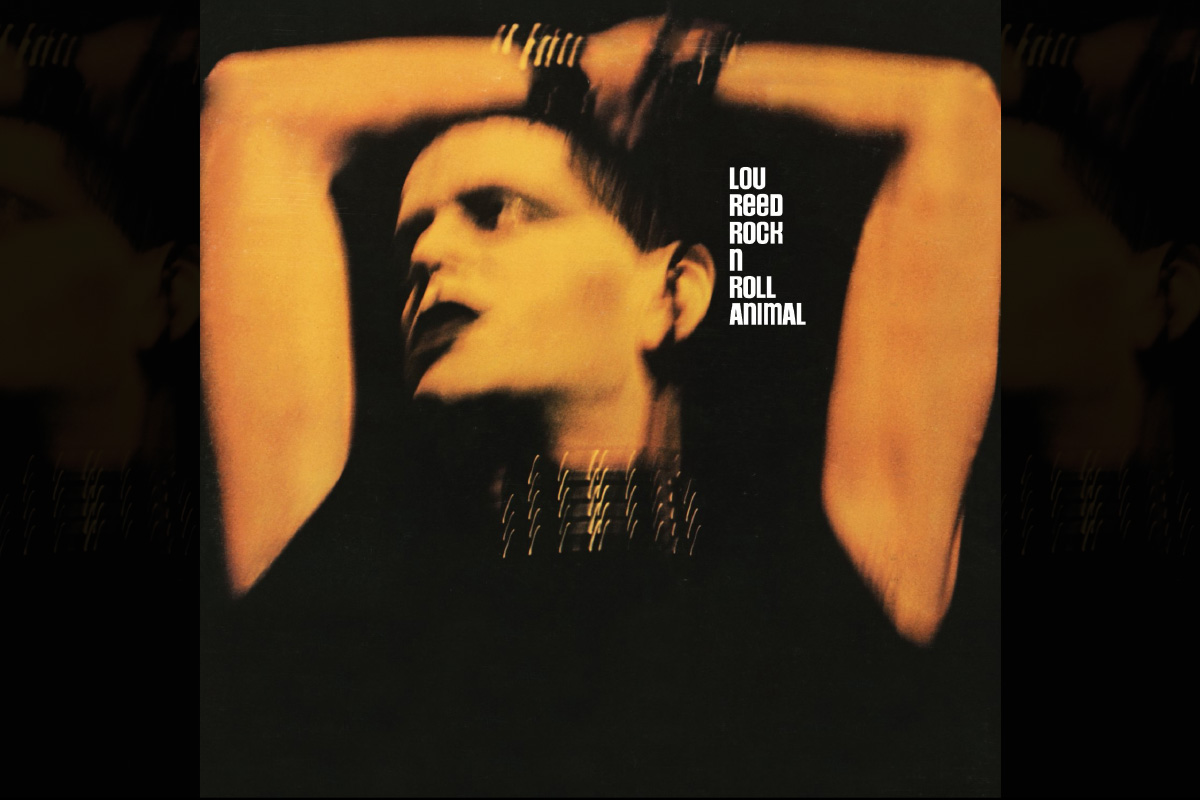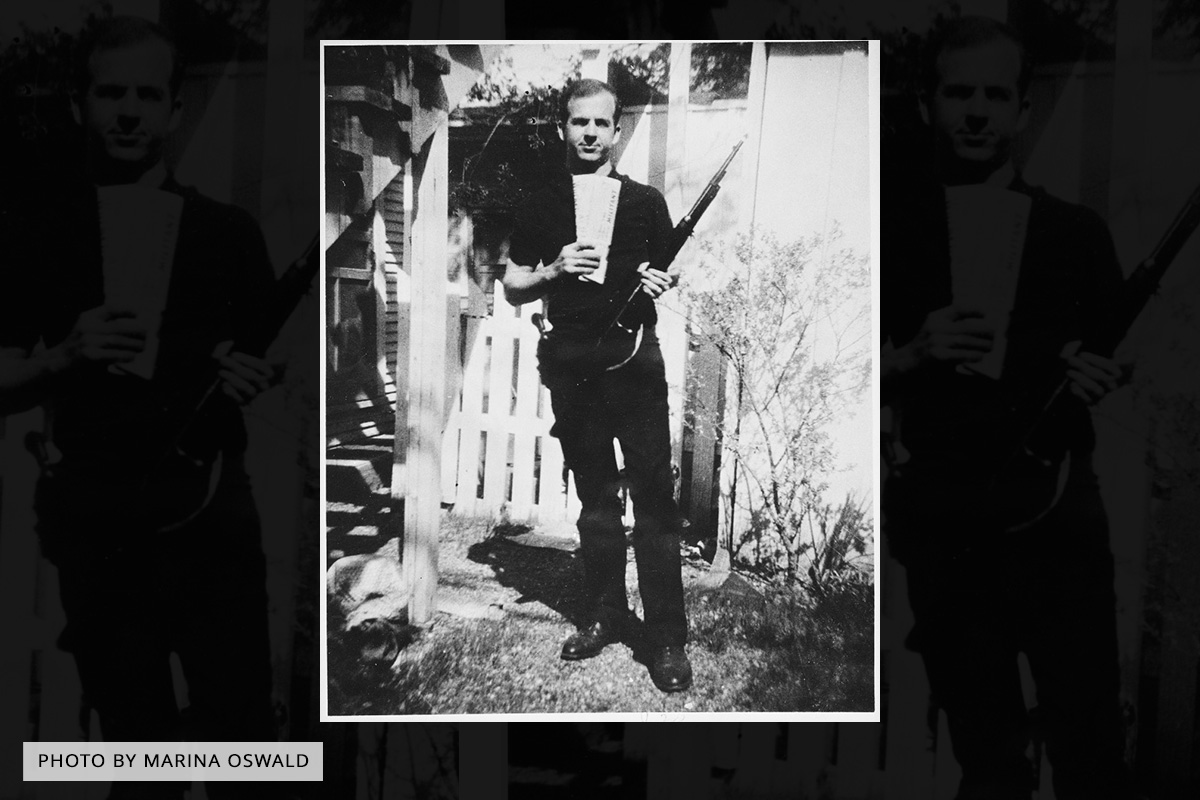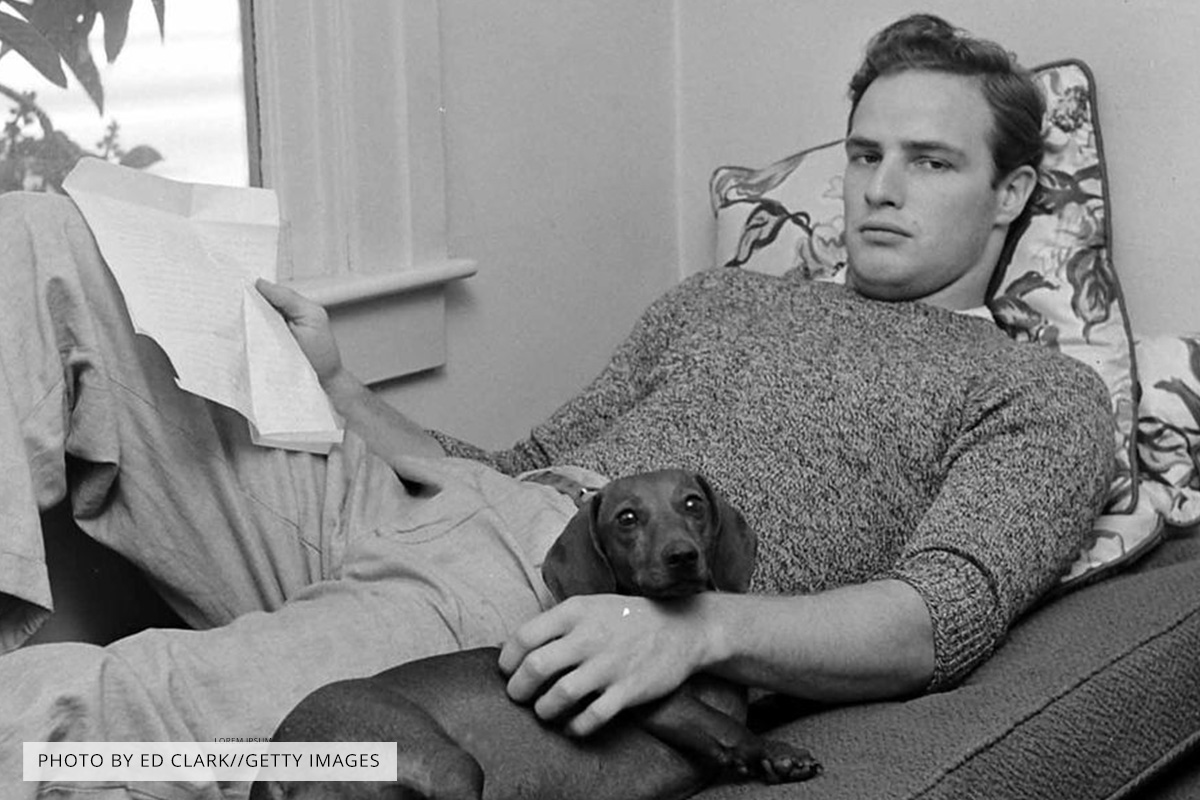©2024 By Burt Kearns

“Marlon Brando: Hollywood Rebel,” the new book by author, journalist, pop culture authority —and Legsville contributor– Burt Kearns, was published to coincide with the great actor’s centennial. It is “not another Marlon Brando biography,” Kearns insists in the book’s prologue, “nor a hagiography—but a study of how one man’s artistic and personal decisions affected not only those around him, but all of Western society and popular culture… twenty years after his death, and one hundred years after his birth.” In this exclusive excerpt, Kearns examines Brando’s influence on the pop artist Andy Warhol and other visionary and queer artists in Warhol’s orbit.
Long before he was regarded as the most influential visual artist of the twentieth century, Andy Warhol worshipped Marlon Brando. Brando was a movie star, a handsome, tough yet tender actor whose sexual activity with men as well as women was already rumored and confirmed by some among the gay crowd of 1950s Manhattan. Warhol was a pale, pockmarked, balding, insecure, yet very successful commercial illustrator and artist, but he loved sex, and he loved Marlon Brando. One of his good friends, production designer Charles Lisanby, recalled the time Warhol showed him just how close he kept his screen idol to his . . . heart. “I do remember Andy coming to the display department once, and he said, ‘I was just at Harper’s Bazaar, and he gave me a picture of Marlon Brando. Would you like to see it?’ And I said, ‘Sure, Andy. Yeah.’ And he went into his pants and he had it in there. . . . And he showed the photo to me. Then he put it back in. And he was walking around New York with Marlon Brando in (his pants).”
Brando, the leather boy biker in The Wild One and the brutish Stanley Kowalski in A Streetcar Named Desire, could be seen as the man Warhol always wished he could be, or at last the man he wished he could have. Warhol had been infatuated with cinema and movie idols since he was a child in Pittsburgh, Pennsylvania, collecting movie fan magazines and sending away for photos of the stars, and Hollywood was a focus of the pop art that Warhol pioneered. So, it is not surprising that Brando, a man whose rebellious attitudes on screen and in life mirrored his own, would be a major influence on some of Warhol’s most celebrated—and valuable—work.
Warhol worked in many mediums, including illustration, painting, silk-screening, photography, sculpture, film, and video. His work embraced and satirized consumerism, mass media, and celebrity, and his use of related items, products, totems, scraps, and images from popular culture—sometimes produced on a mass scale—created a statement that went far beyond the label of “pop art.”
By 1962, Warhol was already considered a great talent and a force to be reckoned with on the New York art scene, but the major fine arts dealers considered his pop art paintings to be too outré to be featured in major gallery exhibitions, let alone a solo show. When he received an offer for his first one-man show, it was from an art dealer based in Los Angeles, for an exhibition at the Ferus Gallery on North La Cienega Boulevard. Los Angeles wasn’t even on the map as far as the East Coast art establishment was concerned. Irving Blum and his partners at the Ferus Gallery had attempted to make an impression by featuring the West Coast’s most cutting-edge artists. Now, they were reaching farther.
Blum recalled visiting Warhol in his townhouse on Lexington Avenue near Eighty-Ninth Street in Manhattan. “What really made an impression was that the floor—I may exaggerate a little—was not a foot deep, but certainly covered wall-to-wall with every sort of pulp movie, magazine fan magazine, and trade sheet having to do with popular stars from the movies or rock ’n’ roll. Warhol wallowed in it.”
Warhol’s show at the Ferus Gallery opened on July 9, 1962, and the highlight was not Hollywood, but the supermarket shelves. Andy Warhol: Campbell’s Soup Cans was the first exhibition of his Campbell’s Soup Cans, thirty-two separate twenty-by-sixteen-inch canvases, each displaying a painting of one of the thirty-two varieties of Campbell’s canned soup. This masterwork was the introduction of pop art to the West Coast.

Hollywood Babylone by Kenneth Anger, published in France in 1959
By the time the Ferus show had opened, Warhol was back in New York, concentrating on a vision of Hollywood that stemmed from his lifetime of obsession with movie stars, wrapped in the queer culture and the Hollywood scandals revealed, detailed, and embellished by avant-garde filmmaker Kenneth Anger in his book Hollywood Babylone, published in France in 1959 (published in the United States in 1965 as Hollywood Babylon and quickly banned).
Some of Warhol’s first silkscreen experiments in 1962 made use of a publicity photo of Elizabeth Taylor, enlarged, turned to a stencil, transferred to a canvas, painted over, and reproduced like another commercial “product”—his own comment on the Hollywood machine. His other subjects included Warren Beatty, Troy Donahue, Elvis Presley, and Marilyn Monroe. Warhol was working on a series of Monroe paintings depicting a detail from a bust-length publicity still from the 1953 film Niagara, when Monroe died on August 4.
The death gave the work even more importance when the dozen paintings of Marilyn Monroe, later known as the Flavor Marilyns, were the highlight of his first solo show in New York City. The exhibit opened on November 6, 1962 at the Stable Gallery on East Seventy-Fourth Street in Manhattan. Each acrylic and silkscreen image was painted on a twenty-by-sixteen-inch canvas with a different colored background. (The paintings were offered for sale at two hundred and fifty dollars apiece.) Warhol’s first show also included paintings and silkscreens depicting Elvis, Donahue, Coca-Cola bottles, dollars bills and a Pepsi Cola matchbook. “Shock value was built into pop art and Andy Warhol, one of its stellar performers, capitalizes on just that,” Stuart Preston wrote in the New York Times. “Popular images such as coca-cola bottles; Marilyn Monroe’s radiant smile; and Elvis Presley’s sensual sulkiness are repeated in rows as if the canvases had been sprayed by image-making machine guns. This is ‘art’ in that Warhol knows more than a thing or two about color and layout, but its sociological value—that of making icons for sophisticates—is considerably higher.”
Heading into 1963, Warhol’s art had taken a darker, more serious turn as he began work on what would become known as the Death and Disaster series: images of car crashes, electric chairs, suicides, race riots, and other topics that reflected an American obsession with violence and tragedies. Simultaneously, he was attacking Hollywood mythology and celebrity culture straight on, with a more prominent queer sensibility, influenced not only by the fan mags and Hollywood Babylone, but Flaming Creatures, the recent underground film by Jack Smith. A sexually graphic display of performers in drag, transvestites, and orgies, Flaming Creatures was an underground sensation, local scandal, and cause célèbre, leading to obscenity charges, audience consternation, and Warhol’s purchase of a Bolex sixteen-millimeter film camera and turn to filmmaking. For his first movie project, Warhol filmed his lover, stockbroker-turned-poet John Giorno, as he slept, then looped and slowed the film and added footage until he had a six-and-a-half-hour picture, Sleeping (Warhol later added ninety minutes to approximate the accepted eight-hour sleep time).

Silver Marlon, Andy Warhol, 1963
In January 1963, Warhol moved his studio from his townhouse to the third floor of an abandoned fire house a few blocks away on East Eighty-Seventh Street. He and assistant Gerard Malanga began working on several silkscreens for a second Ferus show. All were based on a single, oversized image of Marlon Brando as Johnny Strabler. Created from a promotional still from The Wild One, the image was silkscreened on a linen background that had been painted silver—as on the silver screen. “It was only natural that, in 1963, Warhol should have turned to the image of Brando leaning on his motorbike to create a silver-backed altarpiece to cool,” according to a description of Silver Marlon from Christie’s auction house, decades later. “Brando’s character in the film even has a Warholian aspect in some of his terse dialogue. . . . Johnny’s all-out, motiveless, empty war on the status quo was arguably echoed in the gauntlet that Warhol himself would take up with Pop almost a decade later.”
“What are you rebelling against. . . Andy?” “Whaddaya got?”
Warhol also worked on reconceiving another photograph of Elvis Presley. This was a publicity still from Flaming Star, the western directed by Don Siegel in 1960. Elvis was in the role that had been written for Brando; one of the futile attempts to revive Elvis’s Brando-influenced dramatic career after his return from military service. The photograph did not depict Elvis as rock ’n’ roll star or dreamy teen idol, but as a cowboy, the archetypal American hero, legs in a wide stance, right hand gripping and pointing a six-shooter. Warhol turned the photo into a life-size image on another silver background, on canvas, over six feet tall. In the mass production phase of his art, he made forty-eight copies and sent all of them, along with a collection of Elizabeth Taylor portraits, to Irving Blum at the Ferus Gallery.
“Andy sent a roll of printed Presley images, an enormous roll, and sent a box of assorted-size stretched bars,” Blum recalled.
I said, “You mean, you want me to cut them? Virtually as I think they should be cut and placed around the wall?” And he said, “Yes, cut them any way that you think you should. . . . The only thing I really want is that they should be hung edge to edge, densely—around the gallery.” And that’s exactly what I did. Sometimes the images were superimposed one over the next. Sometimes they sat side by side. They were of varying sizes. All the same height—roughly six and a half feet, as I recall. Really, life size. And I got as many stretched up as required to fill densely—the gallery, as per Andy’s instructions. And I sent what was left on the roll back to Andy and opened the exhibit.

Triple Elvis (Ferus type), Andy Warhol, 1963
Warhol’s second show at the Ferus Gallery was all Elvis and all he represented. The ten portraits of Elizabeth Taylor were relegated to a back room for viewing by appointment only, but with her inclusion, just as Jack Kerouac had once enshrined Presley, Dean, and Brando as America’s “New Trinity of Love,” Warhol announced his own trio of queer icons. All three were tragic figures, stars of movie mags and idolized by gay fans. Marilyn had died the previous summer; Liz always seemed on the edge of death and was famously reported dead erroneously in 1961 when she was stricken with pneumonia during the disastrous production of Cleopatra. She was saved only by having her neck slit open in a tracheotomy. Elvis Presley was, in some ways, the walking dead in cool pop culture, and Warhol saw the tragedy in what had become of his career and potential as a true rebel. There also was a far more openly queer subtext in a reading of this series of paintings. Elvis was presented as a “flaming star”—“flaming,” as in the slang for a stereotypically effeminate homosexual. Elvis, once the rock ’n’ roll rebel, was one of Jack Smith’s “flaming creatures.” With his crotch at the center of the image, legs spread and pointing that gun, the stereotypical phallic symbol, the King was reduced—or elevated—to a camp parody of the western hero.
Silver Marlon, the leather-clad motorcycle movie rebel, was not part of this latest attack on the mainstream. Brando did not figure into that picture—or at least that’s what was believed at the time. Years later, Gerard Malanga pulled from a shelf in Warhol’s library a book on French film theory that the artist had looked to as a guide while working on his first Marilyn Monroe project. One can imagine Malanga’s shock when he opened the book and saw inside its front cover a display of ten identical photographs of Marlon Brando, with a gun, in the same position as Warhol’s Elvises. Once again, Marlon Brando was the model for Elvis Presley, and the inspiration for Andy Warhol.
* * *
Brando’s place in the Warhol pantheon would be enshrined a few years later, under very different circumstances, in a series of eight canvases titled Marlon. In 1966, Warhol, the avant-garde director of an eight-hour stationary view of the Empire State Building and seventy minutes of Taylor Mead’s Ass, had ventured into the mainstream with The Chelsea Girls, a movie that was shot mainly at the Chelsea Hotel in New York City and made use of black-and-white and color film stock and split screen—two separate images and soundtracks running side-by-side—for the three-and-a-half-hour duration. The picture had its first “non-underground engagement” in December at Cinema Rendezvous on West Fifty-Seventh Street. Dan Sullivan wrote in the New York Times that at its best, the film “is a travelogue of hell . . . at its worst it is a bunch of home movies in which Mr. Warhol’s friends, asked to do something for the camera, can think of nothing much to do.”
Warhol was admittedly influenced, once again, by the work of Kenneth Anger. Scorpio Rising was Anger’s twenty-eight-minute experimental film about a gang of Nazi bikers preparing for a race that ends in death. Scored to a collection of sixties pop songs, with no dialogue save for some screams and animal roars, the film is a meditation on biker culture, leather fetishism, homosexuality, sadomasochism, the occult, Christianity, Naziism—and the heroes of this homoerotic cult, James Dean and Marlon Brando. While Dean is seen in photographs tacked to a bedroom wall, along with a skull-and-crossbones flag resembling the logo of the Black Rebels Motorcycle Club, Brando is seen in clips from The Wild One, on a blue-tinted television screen. Amid a party scene that evolves into a sadomasochistic homosexual orgy (that includes one biker pounding on a shades-of-Brando conga drum), the image of Brando as Johnny Strabler is intercut with that of Jesus Christ (in clips from the 1927 silent film, King of Kings), and, ultimately, Adolf Hitler, as Little Peggy March sings “I Will Follow Him.” Anger takes whatever queer subtext was attributed to The Wild One and makes it religion.
“The main influence in Scorpio Rising, which is shown in great loving detail, is the leather jacket that Kenneth created for the movie, which was inspired by Brando,” says the historian David Del Valle, a longtime friend of Anger. “But after watching these scenes in The Wild One, I see what else Anger is doing. The character of Johnny is an iconic representation of masculinity at its most sexual—homosexual. And the fetish of leather is also the promise of sexual conquest and sexual domination, which is part and parcel with a certain kind of sexual fetish within the gay community.”

Production still, Scorpio Rising, 1963
Del Valle says that Anger talked about Brando “all the time. Kenneth’s apartment was like a shrine to Rudolph Valentino, but in another part of the room was the leather jacket from Scorpio Rising on a mannequin. I think he tried to bid in an auction on the cap that Brando wore (in The Wild One), but it went to somebody else. He liked ‘bad boys.’ It’s attitude. It’s being uninhibited. Brando represented all that in a very silent way. Kenneth Anger is the number one reason The Wild One became the fetish object it did. Kenneth Anger, Tom of Finland, and Andy Warhol, all three as artists saw what this film was stirring up.”
(Anger spoke of the real-life bikers who were homoeroticized, fetishized, and demonized in Scorpio Rising, in an unpublished 1997 interview with pop historian Legs McNeil: “They weren’t that outlaw. They weren’t Hells Angels. They weren’t involved in any criminal activity to speak of. They were Italian-Americans who worked all night in the Fulton Fish Market, but they were obsessed with motorcycles, and they put all their money into the motorcycles. And they were straight guys. They weren’t gay, but their mistresses were the motorcycles, not their girlfriends. The girlfriends knew that they took second place. So they’re going to have a Halloween party. I said, ‘I’d like to do some filming.’ I don’t know what it would’ve been like if I hadn’t been there with my camera, but I never said, ‘Take your pants down.’ I never said, ‘Take your dick out.’ That was their idea. So I got most of it on film and the funny thing is, during this time their girlfriends were all present behind the camera.”)
Warhol used the same Silver Marlon image for the new Marlon series, but replaced the silver background with a raw, untreated canvas. This, according to the auction house, had “devastating effect. Warhol’s decision to use the canvas in its natural state adds to the subversive nature of the painting, enhancing the feeling of masculinity and edginess and adding another layer to the depiction of the counter-culture that is already contained within the image itself.” The image of Brando was relegated to the right side of the canvas, leaving a large section untouched, placing even more emphasis on the black lines of the image.
Now, Brando as Johnny Strabler in the Marlon series had been reimagined, reprocessed, and remade, not only by Kenneth Anger but Andy Warhol. Any fantasies that Warhol may have had about the actor were now being produced for public consumption. The iconic image of the cool motorcycle rebel, from his leather to his chains to his “whaddya got” attitude, no longer represented a tough, straight marauder, but was part of the Warholian gallery of Hollywood queens. All subtext had risen to the queer surface. In the summer of 1967, Warhol even directed a film that was his own take on motorcycle culture. In Bike Boy, he cast Joe Spencer, an actual biker gang member described in the New York Times as “a muscular youth with an angelic face and an early Brando dese-dem-dose vocabulary,” as a motorcyclist who showers for the camera and is mocked by Warhol’s clique of outré characters he dubbed “superstars.” Once again, any pretense of straight macho heroism among the “vanishing breed” of outlaw bikers was skewered when tossed into the Warhol world.

Double Marlon, Andy Warhol, 1966
Only three of the eight Marlon canvases repeated the image of Brando and his bike. One of the most effective and striking versions was Double Marlon, which featured two of the images stacked on the right third section of a very large canvas—84 × 95¾ inches—leaving two-thirds of the canvas untouched. This again makes the images even more powerful, as if they are frames on a strip of film. The vertical strip also resembles, an art curator wrote, “a screen awaiting projection (and) even recalls the dual projection techniques that Warhol had used in The Chelsea Girls.”
Four Marlons, along with Warhol’s Triple Elvis (Ferus Type)—three overlapping images of Elvis Presley—went up for bidding at Christie’s Rockefeller Center Auction house on November 12, 2014. Elvis sold for $82 million. The lesser-known Brando sold for $69.6 million. On the eve of the auction, Brett Gorvy, Christie’s worldwide chairman of postwar and contemporary art, told a reporter for the New York Times that of the two, Brando and Presley, “Marlon speaks to a younger audience, because there is a very raw sexuality to the image. He’s the person every young actor wants to be.”
In February 2023, Warhol’s portrait of Brando was a centerpiece of Saudi Arabia’s first exhibition of Warhol’s works. FAME: Andy Warhol in AlUla was part of the second annual AlUla Arts Festival, a government-funded initiative to bolster the country’s reputation as an arts destination (or, according to Human Rights Watch, “a deliberate strategy to deflect from the country’s image as a pervasive human rights violator”).
The show’s curator, Patrick Moore, director of the Andy Warhol Museum in Pittsburgh, said in a statement that FAME was intended to reach new audiences and to introduce Saudi youth to Warhol through a “fascinating”—and relatable—aspect of his work. “Andy Warhol’s journey, which started as a child staring at the movie screen and collecting publicity stills, is becoming more common through the rise of social media.”
999
BURT KEARNS is an author, journalist, and television and film writer and producer. His book, Marlon Brando: Hollywood Rebel can be purchased online, in stores, and at MarlonBrandoBook.com. His next book, Shemp: The Biography of the Three Stooges’ Shemp Howard, The Face of Film Comedy, will be published on October 1, also by Applause Theatre & Cinema Books.







